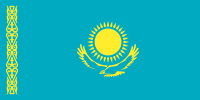 Kazakhstan (also spelled Kazakstan, Kazakiya, Qazaqiya, Kazakh: Қазақстан, Қазақия, Қазақ Елі, Qazaqstan, قازاقستان,), officially the Republic of Kazakhstan, is one of the six independent Turkic states. It is located in Eurasia and ranked as the ninth largest country in the world. It is also ranked the world’s largest landlocked country, its territory of 2,727,300 km² is greater than Western Europe. It is neighbored clockwise from the north by Russia, China,Kyrgyzstan, Uzbekistan, Turkmenistan, and also borders on a significant part of the Caspian Sea. The capital was moved in 1997 from Almaty, Kazakhstan’s largest city, to Astana.
Kazakhstan (also spelled Kazakstan, Kazakiya, Qazaqiya, Kazakh: Қазақстан, Қазақия, Қазақ Елі, Qazaqstan, قازاقستان,), officially the Republic of Kazakhstan, is one of the six independent Turkic states. It is located in Eurasia and ranked as the ninth largest country in the world. It is also ranked the world’s largest landlocked country, its territory of 2,727,300 km² is greater than Western Europe. It is neighbored clockwise from the north by Russia, China,Kyrgyzstan, Uzbekistan, Turkmenistan, and also borders on a significant part of the Caspian Sea. The capital was moved in 1997 from Almaty, Kazakhstan’s largest city, to Astana.
Vast in size, the terrain of Kazakhstan ranges from flatlands, steppes, taigas, rock-canyons, hills, deltas, and snow-capped mountains to deserts. With 16.2 million people (2010 census). Kazakhstan has the 62nd largest population in the world, though its population density is less than 6 people per square kilometre (15 per sq. mi.).
For most of its history, the territory of modern-day Kazakhstan has been inhabited by nomadic tribes. By the 16th century the Kazakhs emerged as a distinct group, divided into three hordes. The Russians began advancing into the Kazakh steppe in the 18th century, and by the mid-19th century all of Kazakhstan was part of the Russian Empire. Following the 1917 Russian Revolution, and subsequent civil war, the territory of Kazakhstan was reorganised several times before becoming the Kazakh Soviet Socialist Republic in 1936, a part of the USSR. During the 20th century, Kazakhstan was the site of major Soviet projects, including Khrushchev’s Virgin Lands campaign, the Baikonur Cosmodrome, and the Semipalatinsk “Polygon”, the USSR’s primary nuclear weapon testing site.
Kazakhstan declared itself an independent country on December 16, 1991, the last Soviet republic to do so. Its communist-era leader, Nursultan Nazarbayev, became the country’s new president. Since independence, Kazakhstan has pursued a balanced foreign policy and worked to develop its economy, especially its hydrocarbonindustry. While the country’s economic outlook is improving, President Nazarbayev maintains strict control over the country’s politics. Nevertheless, Kazakhstan’s international prestige is building. It is now considered to be the dominant state in Central Asia. The country is a member of many international organizations, including the United Nations, NATO’s Partnership for Peace, the Commonwealth of Independent States, and the Shanghai Cooperation Organisation. In 2010, Kazakhstan is chairing the Organization for Security and Co-operation in Europe.
Kazakhstan is ethnically and culturally diverse, in part due to mass deportations of many ethnic groups to the country during Stalin’s rule. Kazakhs are the largest group. Kazakhstan has 131 nationalities including Kazakh, Russian, Ukrainian, Uzbek and Tatar. It has a population of 16.0 million, of whom around 63% percent are Kazakhs.
Kazakhstan allows freedom of religion, and many different beliefs are represented in the country. Islam is the primary religion. The Kazakh language is the state language, while Russian is also officially used as an “equal” language (to Kazakh) in Kazakhstan’s institutions.
Before the Russian colonization, the Kazakhs had a highly developed culture based on their nomadic pastoral economy. Although Islam was introduced to most of the Kazakhs in the fifteenth century, the religion was not fully assimilated until much later. As a result, it coexisted with earlier elements of Tengriism.
Traditional Kazakh belief held that separate spirits inhabited and animated the earth, sky, water and fire, as well as domestic animals. To this day, particularly honored guests in rural settings are treated to a feast of freshly killed lamb. Such guests are sometimes asked to bless the lamb and to ask its spirit for permission to partake of its flesh. Besides lamb, many other traditional foods retain symbolic value in Kazakh culture.
Despite Kazakhstan’s largely arid conditions, its vast steppes accommodate both livestock and grain production. In the 1950s, the Virgin Lands Program under Soviet Communist party chief Khrushchev brought hundreds of thousands of Russian, Ukrainian, and German settlers to the area. Wheat, cotton, sugar beets, and tobacco are the main crops. The raising of cattle and sheep is also important, and Kazakhstan produces much wool and meat. In addition, in the N Caspian there are rich fishing grounds, famous for their caviar-producing sturgeon, although these have been hurt by overfishing.
Notes from Wikipedia and Answers.com









